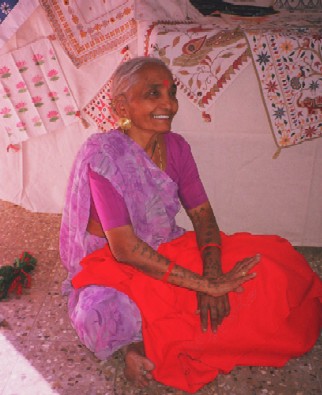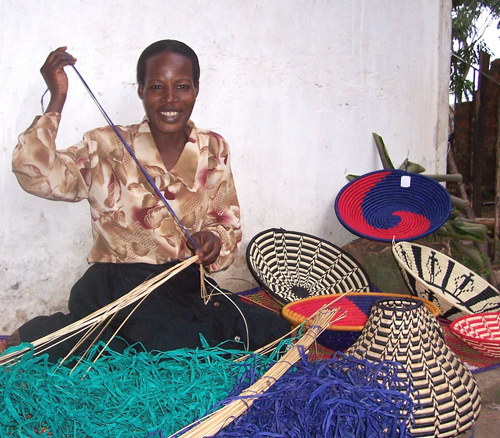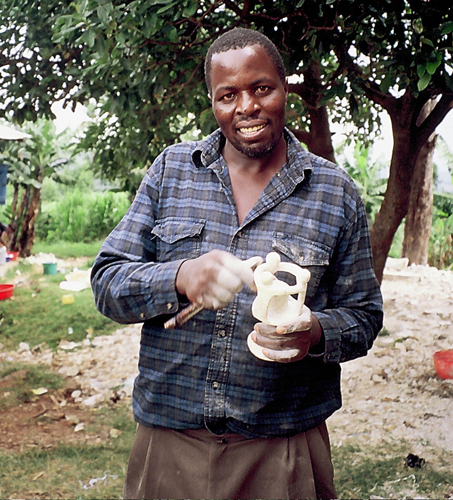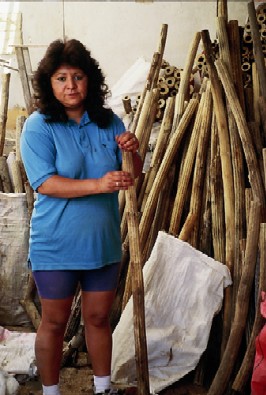Navigation
Ten Thousand Villages Provides Fair Income to Artisans
Artisans in developing countries lack access to local and international markets to sell their handicrafts.
Problem/Challenge:
Artisans in developing countries lack access to local and international markets to sell their handicrafts.
Extreme poverty is defined as living on less than $1 a day. Today, one in five people around the world live in extreme poverty.[1] Because poverty is often the result of many colliding circumstances, it is difficult to combat. Most causes of poverty lie beyond the control of its victims. War, political strife, famine and overcrowding leave many people either unemployed or underemployed. Women are disproportionately affected by poverty due to structural and cultural barriers that limit their ability to earn an income. Women are also more likely than men to suffer from hunger, and over half of the world’s 19.2 million refugees are women and their dependent children.[2]
Prior to World War II, handicraft production in Third World countries provided supplemental income for subsistence-based communities during the off-season. However, in the second half of the twentieth century, First World manufacturers began to exploit the cheap labor and resources available in Third World nations, contributing to a rise in industrialization and urbanization. These two forces drew many subsistence farmers away from their land to the cities in search of employment. This economic transition period also introduced machine-made substitutes for handmade products, which resulted in fierce competition that put many small-scale handicraft producers out of business. It has become increasingly difficult for handicraft producers to sell their products in local markets.
As globalization and economic interdependence have increased, Third World nations have become increasingly dependent on the more prosperous countries of the First World for economic development. This has resulted in social disintegration and subsequently a loss of dignity and self-worth among peoples in the Third World.
Ten Thousand Villages recognizes the universal human need to be validated. It operates under the assumption that employment is crucial to the restoration of dignity.
 |
| Santo Shlauji |
On January 16, 1978, Paul Leatherman, former CEO of Ten Thousand Villages (then SELFHELP Crafts), wrote, “We could continue to give relief, but all people need to feel the dignity and self-respect that is part of helping themselves, developing themselves.”
Ten Thousand Villages works only with artisans who would otherwise be unemployed or underemployed, the majority of whom are women and other disadvantaged populations.
The income that artisans earn through fair trade helps them to buy food, education, health care and housing.
 |
| Dorothy Nabakiibi Photo by Ten Thousand Villages |
Initiative:
Ten Thousand Villages provides vital, fair income to Third World people by marketing their handicrafts and telling their stories in North America.
Ten Thousand Villages works with artisans who would otherwise be unemployed or underemployed. The income artisans earn helps pay for food, education, health care, and housing.
Background:
Ten Thousand Villages is one of the oldest and largest fair trade organizations in the world. Fair trade organizations connect consumers in North America, Europe, Japan and Australia to unemployed and underemployed artisans and farmers in developing countries through fair trade relationships benefiting people, rather than maximizing their own profits. The artisans’ income helps pay for food, education, health care and housing.
Ten Thousand Villages started with a very simple idea. In 1946, Edna Ruth Byler, a volunteer for Mennonite Central Committee (MCC), visited a sewing class that was run by two MCC workers in Puerto Rico.
 |
| Edna |
Edna Ruth discovered extraordinary embroidered pieces, hand sewn by local Puerto Rican women. However, many of these talented craftspeople lived in extreme poverty and had no local market to sell their products. She realized that if the women had more places to sell their wares, their lives would improve.
Edna Ruth brought some pieces home to Akron, Pennsylvania to sell to friends and neighbors and the concept of Ten Thousand Villages was born. After selling her initial purchases, Edna Ruth continued to send orders back to the women’s sewing group in Puerto Rico. By 1952, Edna Ruth’s project was earning more than $400 per month. The popularity of the Puerto Rican handicrafts inspired Edna to expand her business to include cross-stitch from Palestinian refugees and hand carved Haitian woodenware. She became affectionately known as the “Needlework Lady,” and in 1952 Edna Ruth’s business became a nonprofit program of MCC called the Overseas Needlepoint and Crafts Project. In 1968 the program changed its name to SELFHELP Crafts.
The first SELFHELP Crafts retail store opened in 1972 and by the end of the decade there were nearly 60 SELFHELP Crafts stores in the United States. Steady upward growth during the 1970s prompted the organization to undertake a self-evaluation, which reaffirmed the belief that SELFHELP Crafts should exist primarily for the producer. The evaluation also prompted SELFHELP Crafts to change its structure from being a program of MCC to a wholly owned subsidiary of MCC. The structural change meant that SELFHELP Crafts began to operate as a financially independent non-profit organization and no longer competed for donations made to MCC.
Another important date in the history of the organization occurred on September 20, 1996 when SELFHELP Crafts changed its name to Ten Thousand Villages. The inspiration for the name Ten Thousand Villages comes from a Mahatma Gandhi quote: “…India is not to be found in its few cities but in the 700,000 villages…we have hardly ever paused to inquire if these folks get sufficient to eat and clothe themselves with.” According to Ten Thousand Villages CEO, Paul Myers, it has been one of the two or three most significant decisions made in the 59-year history of Ten Thousand Villages. In 1996 Ten Thousand Villages purchases were $2,400,000 and sales were $6,200,000. In 2005, Ten Thousand Villages is purchasing $6,200,000 and will sell approximately $19,000,000.
Since 1946 Ten Thousand Villages has supported the work of literally tens of thousands of artisans in over 30 countries in Asia, Africa, Latin America and the Middle East. Working with more than 100 artisan groups, Ten Thousand Villages purchases fine pieces from craftspeople with whom it has developed longstanding, nurturing relationships. Ten Thousand Villages partnerships with artisans are based on mutual understanding and respect. Being linked to Mennonite Central Committee (MCC) has given Ten Thousand Villages a worldwide network of volunteers and like-minded organizations that enable the organization to be in touch with and know the artisans and groups with whom it works.
 |
| John Ogaoabuya |
In addition, Ten Thousand Villages has always sought to work with artisans who are particularly disadvantaged and who do not have access to resources or assistance.
The true testament to the success of Ten Thousand Villages success is demonstrated by the stories of the artisans it partners with.
Maya Halder, a woman who lives in Agailjhara, Bangladesh and makes palm leaf star garlands for Ten Thousand Villages, is a good example of how Ten Thousand Villages is affecting change on an individual level.
When asked how fair trade relationships with organizations such as Ten Thousand Villages has improved her life, Maya had this to say:
“We are poor distressed women working at Keya Palm to build our lives. By working together we are able to overcome our problems. We become united in one mind. We will send our children to school with our earnings. Also, we are able to purchase our food and clothing. From our profits, we plow our gardens and cultivate crops, we repair our houses and plant trees.”
Ten Thousand Villages expanding retail network connects North American consumers with handicrafts and stories of tens of thousands of artisans worldwide.
 |
| Miriam Luis |
In addition to being the largest fair trader for handicrafts in North America, Ten Thousand Villages is a founding member of the International Fair Trade Association, an organization that includes over 200 members in 55 countries, including many artisan cooperatives from the South. Ten Thousand Villages is a leader in the worldwide fair trade movement that is striving to improve the lives of disadvantaged people in developing countries.
Implementation Status:
Ten Thousand Villages continues to grow its North American market in order to buy more from the artisans it works with. In August 2005, Ten Thousand Villages launched a new e-commerce website to support the sales from retail stores. Additionally, Ten Thousand Villages opened five new stores in 2005. Ten Thousand Villages aims to double its sales over the next five years. It is currently growing at a rate of approximately 15 percent per year. The gift retail market in the United States is a multi-million dollar a year industry and there is a huge potential for fair trade to become a sizeable portion of that market.
During the fiscal year, which ended on March 31, 2005, Ten Thousand Villages sold $16,085,864, an increase of five percent over the previous year. Cash flow, inventory levels and outstanding receivables all improved substantially. According to Ten Thousand Villages CEO, Paul Myers, Ten Thousand Villages has set two primary goals for the new fiscal year: first, to significantly increase sales in all existing stores, and second, to open several new stores by October 1 in good locations in a sustainable manner.
Achievement of these two goals will mean growth of more than 15 percent during the next year with approximately one-half of it coming from new store growth and one-half from existing store growth. To keep this in perspective, Ten Thousand Villages growth during the four years from 2000 to 2003 was 15.6%, with the highest of those four years being 18.8%.
Ten Thousand Villages commitment to its mission is as strong as ever. It continues to increase its sales in North American markets in order to buy more from artisans. As Myers said, “There is no adequate substitute for giving artisans another order.”
[1] http://www.one.org/Issues.html
2 http://www.unhcr.ch/cgi-bin/texis/vtx/statistics
Follow-up Strategy: |
Anticipated or Known Documentation Endeavors: Videos are available for people who wish to help Ten Thousand Villages by making presentations, soliciting volunteers, or by starting a Ten Thousand Villages store. |
Contact and Submitter Information:
Solution Organization: | Ten Thousand Villages e-commerce website & informational website about fair trade and Ten Thousand Villages |
Organization Reference People:
Juanita Fox, Media Coordinator
(1) 717-859-8120
juanita.fox@tenthousandvillages.com
Lisa Stratton, Marketing Fellow
(1) 717-859-8116
lisa.stratton@tenthousandvillages.com
704 Main Street, P.O. Box 500
Akron, PA
17501
U.S.A.
Fax: (1) 717-859-2622
Tel: (1) 717- 859-8100
Date of Information: | January 28, 2006 |
Location (region, country): | USA |
Source of Information: | Ten Thousand Villages |
Search
Latest articles
Agriculture
- World Water Week: Healthy ecosystems essential to human health: from coronavirus to malnutrition Online session Wednesday 24 August 17:00-18:20
- World Water Week: Healthy ecosystems essential to human health: from coronavirus to malnutrition Online session Wednesday 24 August 17:00-18:20
Air Pollution
- "Water and Sanitation-Related Diseases and the Changing Environment: Challenges, Interventions, and Preventive Measures" Volume 2 Is Now Available
- Global Innovation Exchange Co-Created by Horizon International, USAID, Bill and Melinda Gates Foundation and Others
Biodiversity
- It is time for international mobilization against climate change
- World Water Week: Healthy ecosystems essential to human health: from coronavirus to malnutrition Online session Wednesday 24 August 17:00-18:20
Desertification
- World Water Week: Healthy ecosystems essential to human health: from coronavirus to malnutrition Online session Wednesday 24 August 17:00-18:20
- UN Food Systems Summit Receives Over 1,200 Ideas to Help Meet Sustainable Development Goals
Endangered Species
- Mangrove Action Project Collaborates to Restore and Preserve Mangrove Ecosystems
- Coral Research in Palau offers a “Glimmer of Hope”
Energy
- Global Innovation Exchange Co-Created by Horizon International, USAID, Bill and Melinda Gates Foundation and Others
- Wildlife Preservation in Southeast Nova Scotia
Exhibits
- Global Innovation Exchange Co-Created by Horizon International, USAID, Bill and Melinda Gates Foundation and Others
- Coral Reefs
Forests
- NASA Satellites Reveal Major Shifts in Global Freshwater Updated June 2020
- Global Innovation Exchange Co-Created by Horizon International, USAID, Bill and Melinda Gates Foundation and Others
Global Climate Change
- It is time for international mobilization against climate change
- It is time for international mobilization against climate change
Global Health
- World Water Week: Healthy ecosystems essential to human health: from coronavirus to malnutrition Online session Wednesday 24 August 17:00-18:20
- More than 400 schoolgirls, family and teachers rescued from Afghanistan by small coalition
Industry
- "Water and Sanitation-Related Diseases and the Changing Environment: Challenges, Interventions, and Preventive Measures" Volume 2 Is Now Available
- Global Innovation Exchange Co-Created by Horizon International, USAID, Bill and Melinda Gates Foundation and Others
Natural Disaster Relief
- STOP ATTACKS ON HEALTH CARE IN UKRAINE
- Global Innovation Exchange Co-Created by Horizon International, USAID, Bill and Melinda Gates Foundation and Others
News and Special Reports
- World Water Week: Healthy ecosystems essential to human health: from coronavirus to malnutrition Online session Wednesday 24 August 17:00-18:20
- STOP ATTACKS ON HEALTH CARE IN UKRAINE
Oceans, Coral Reefs
- World Water Week: Healthy ecosystems essential to human health: from coronavirus to malnutrition Online session Wednesday 24 August 17:00-18:20
- Mangrove Action Project Collaborates to Restore and Preserve Mangrove Ecosystems
Pollution
- Zakaria Ouedraogo of Burkina Faso Produces Film “Nzoue Fiyen: Water Not Drinkable”
- "Water and Sanitation-Related Diseases and the Changing Environment: Challenges, Interventions, and Preventive Measures" Volume 2 Is Now Available
Population
- "Water and Sanitation-Related Diseases and the Changing Environment: Challenges, Interventions, and Preventive Measures" Volume 2 Is Now Available
- "Water and Sanitation-Related Diseases and the Changing Environment: Challenges, Interventions, and Preventive Measures" Volume 2 Is Now Available
Public Health
- Honouring the visionary behind India’s sanitation revolution
- Honouring the visionary behind India’s sanitation revolution
Rivers
- World Water Week: Healthy ecosystems essential to human health: from coronavirus to malnutrition Online session Wednesday 24 August 17:00-18:20
- Mangrove Action Project Collaborates to Restore and Preserve Mangrove Ecosystems
Sanitation
- Honouring the visionary behind India’s sanitation revolution
- Honouring the visionary behind India’s sanitation revolution
Toxic Chemicals
- "Water and Sanitation-Related Diseases and the Changing Environment: Challenges, Interventions, and Preventive Measures" Volume 2 Is Now Available
- Actions to Prevent Polluted Drinking Water in the United States
Transportation
- "Water and Sanitation-Related Diseases and the Changing Environment: Challenges, Interventions, and Preventive Measures" Volume 2 Is Now Available
- Urbanization Provides Opportunities for Transition to a Green Economy, Says New Report
Waste Management
- Honouring the visionary behind India’s sanitation revolution
- Honouring the visionary behind India’s sanitation revolution
Water
- Honouring the visionary behind India’s sanitation revolution
- Honouring the visionary behind India’s sanitation revolution
Water and Sanitation
- Honouring the visionary behind India’s sanitation revolution
- Honouring the visionary behind India’s sanitation revolution

